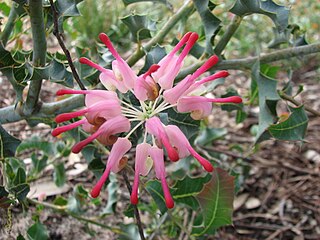
Grevillea leptopoda is a species of flowering plant in the family Proteaceae and is endemic to the south-west of Western Australia. It is a spreading to erect shrub with divided leaves, the lobes further divided, the end lobes linear, and clusters of white to cream-coloured flowers.

Grevillea dielsiana, commonly known as Diels grevillea, is a species of flowering plant in the family Proteaceae and is endemic to the south-west of Western Australia. It is a spreading shrub with divided leaves, the end lobes linear and tapering, and groups of red or orange flowers, often with streaks of pink or cream.

Grevillea candelabroides is a species of flowering plant in the family Proteaceae and is endemic to the west of Western Australia. It is a shrub with pinnately-divided leaves with linear lobes, and white or cream-coloured flowers.

Grevillea flexuosa, commonly known as zigzag grevillea or tangled grevillea, is a species of flowering plant in the family Proteaceae and is endemic to the south-west of Western Australia. It is an erect shrub with divided leaves, these lobes with three to five triangular lobes, and cylindrical clusters of cream-coloured to pale yellow flowers.

Grevillea levis is a species of flowering plant in the family Proteaceae and is endemic to the west of Western Australia. It is a dense shrub with divided leaves, the end lobes linear and sharply pointed, and clusters of white to cream-coloured flowers, sometimes flushed with pink.

Grevillea intricata is a species of flowering plant in the family Proteaceae and is endemic to the west of Western Australia. It is a densely-branched shrub with tangled branchlets, divided leaves with linear lobes and clusters of pale greenish-white to light cream-coloured flowers.

Grevillea paniculata, commonly known as kerosene bush, is a species of flowering plant in the family Proteaceae and is endemic to the south-west of Western Australia. It is a dense shrub with divided leaves, the lobes linear, and more or less spherical clusters of white to cream-coloured flowers.

Grevillea annulifera, also known as prickly plume grevillea, is a species of flowering plant in the family Proteaceae and is endemic to northern Western Australia. It is a spreading to erect shrub with pinnatisect leaves with five to nine sharply-pointed, linear lobes, and cream-coloured to pale yellow flowers.

Grevillea corrugata is a species of flowering plant in the family Proteaceae and is endemic to a restricted area in the south-west of Western Australia. It is a dense shrub with deeply divided leaves usually with three to five sharply-pointed, linear lobes, and white to cream-coloured flowers.

Grevillea acrobotrya is a species of flowering plant in the family Proteaceae and is endemic to the southwest of Western Australia. It is a prickly, spreading to erect shrub with egg-shaped to trowel-shaped leaves with sharply-tipped lobes, and white to cream-coloured flowers with smaller leaves at the base.

Grevillea insignis, commonly known as wax grevillea, is a species of flowering plant in the family Proteaceae and is endemic to the south-west of Western Australia. It is an erect, bushy shrub with more or less oblong leaves with seven to seventeen sharply-pointed, triangular teeth, and more or less spherical or cylindrical clusters of cream-coloured flowers ageing to pink.

Grevillea anethifolia, commonly known as spiny cream spider flower, is a species of flowering plant in the family Proteaceae and is endemic to continental Australia. It is an erect shrub with hairy branchlets, lobed leaves, the lobes sharply pointed, and white to pale yellow or cream-coloured flowers.
Grevillea calcicola is a species of flowering plant in the family Proteaceae and is endemic to the north-west of Western Australia. It is a much-branched shrub with pinnatisect leaves with linear lobes, and off-white to cream-coloured flowers.

Grevillea eryngioides, commonly called curly grevillea, is a species of flowering plant in the family Proteaceae and is endemic to the south-west of Western Australia. It is shrub with low clumping foliage with erect flowering spikes, divided leaves with oblong to egg-shaped lobes, and groups of purplish-red flowers with a yellow style.

Grevillea muelleri is a species of flowering plant in the family Proteaceae and is endemic to the a relatively small area of south-western Western Australia. It is a shrub with linear to narrowly oblong, or divided leaves with linear or narrowly egg-shaped lobes, more or less spherical clusters of white to cream-coloured flowers.
Grevillea murex is a species of flowering plant in the family Proteaceae and is endemic to a relatively small area of south-western Western Australia. It is a spreading, much-branched shrub with hand-shaped leaves and clusters of greenish-white to dull cream-coloured flowers.

Grevillea pyramidalis, commonly known as the caustic bush, is a species of flowering plant in the family Proteaceae and is endemic to north-western Australia. It is an erect, spindly shrub or small tree with simple linear or pinnatisect leaves with linear to narrowly egg-shaped lobes, and white to yellow or cream-coloured flowers.
Grevillea roycei is a species of flowering plant in the family Proteaceae and is endemic to the south-west of Western Australia. It is an open, erect to spreading shrub with divided leaves, the lobes linear to tapering, and more or less spherical clusters of cream-coloured and yellow flowers with a white style.

Grevillea trifida is species of flowering plant in the family Proteaceae and is endemic to the southwest of Western Australia. It is a spiny, erect to low spreading shrub, usually with divided, variably-shaped leaves, and clusters of white to cream-coloured flowers.
Grevillea xiphoidea is species of flowering plant in the family Proteaceae and is endemic to a restricted part of inland areas of Western Australia. It is a dense shrub with divided leaves, the end lobes linear and sharply-pointed, and loose clusters of white to cream-coloured flowers.

















